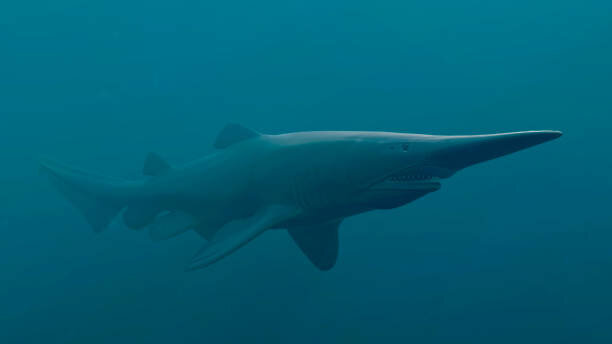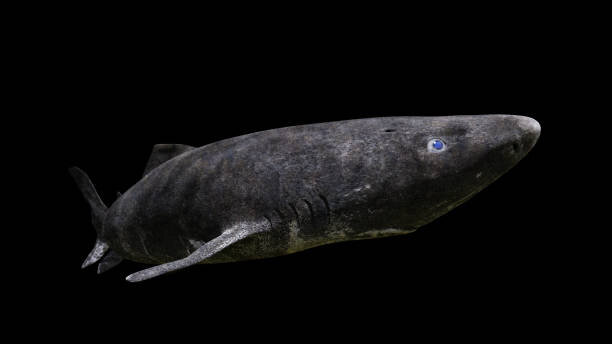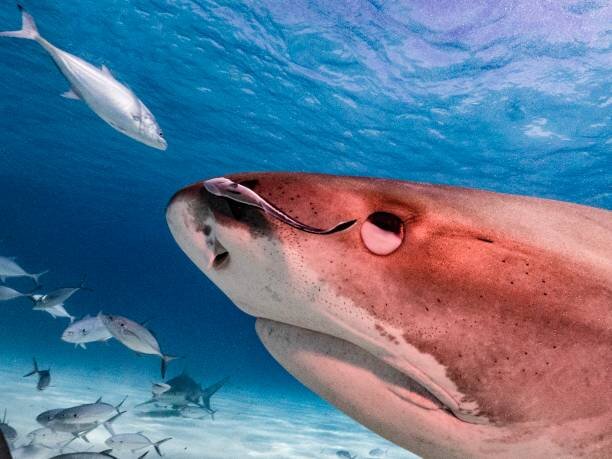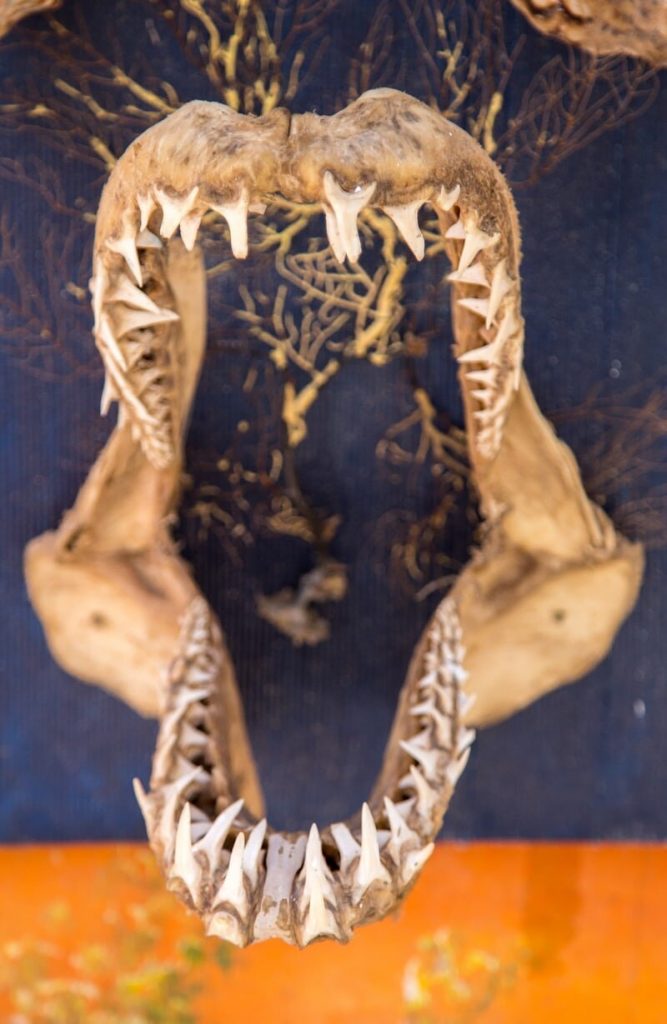Shark Senses
Written by Taylor Tsacoumis
Source : https://ali.fish/blog/shark-senses?rq=tsacoumis
Sharks have been around for over 450 million years, and lived through every mass extinction event including the ice age and asteroid impact that led to the dinosaur extinction — proving that they are one of the most evolutionarily successful creatures to ever live.
Many species of shark have brains as complex as those of mammals, enabling them to process a wide range of senses. The oldest species of shark, the Goblin shark, has been around for about 145 million years and has adapted to the environmental changes of its harsh environment: the deep sea.

The Greenland shark holds the title for longest living vertebrate species. Research indicates they can live to be over 400 years old, yet another example of how well adapted the shark is.

Sharks’ skin is covered in dermal denticles which loosely translates to “skin teeth” because their scales resemble small sharp teeth. Each species of shark has a unique shaped scale that has evolved to its lifestyle and habitat. Researchers can recover these scales in the sand and identify what kind of shark it came from, giving scientists a greater understanding of species-specific distribution.
These scales serve many different functions. Their major role is that they reduce drag and help the shark move effortlessly through the water. The formation and grooves of the scales prevents barnacles or algae from being able to form, which is extremely beneficial especially for the slower moving sharks such as the Greenland shark. They also serve as protection from predators, marine debris, as well as parasites.
Sharks’ unique scale has inspired many inventions such as streamlined wetsuits and bacteria-resistant materials that mimics the pattern of dermal denticles and is much harder for bacteria to grow on.

Sharks have nostril-like openings called nares, which serve as an extremely sensitive sense. Their remarkable sense of smell gives them the ability to differentiate between a potential predator, prey or a mate. Their sense of smell is directional, meaning they are able to detect where a certain smell is coming from. The unique aspect about their sense of smell is that it’s not measured by distance from the origination but the concentration. Some sharks can detect one part of blood in 20 millions parts of seawater, which is equivalent to one teaspoon of blood in a swimming pool. If their left nare encounters the scent first they know their prey is to the left and move that way, in order to continue tracking the odor trail they swim in a zig-zag pattern moving side to side. Contrary to popular belief, sharks do not recognize the scent of human blood as prey because it does not match the smell of fish’s blood. Human blood is composed mostly of water, while a fish’s blood is very oily and much more recognizable to sharks. Therefore when there is human blood in the water sharks will have minimal or no reaction.
Sharks can see about only 15 meters in front of them, meaning their sight becomes their dominant sense only when something is directly in front of them. But, because they have something called a tapetum lucidum, they are able to see in dark murky water. Cats also possess a tapetum lucidum, which is a reflective layer that lies behind the retina, giving their eyes the appearance of glowing in the dark. Sharks’ ability to see in the dark is two times more effective than cats and 10 times more effective than humans. Not all sharks require the same level of sight, it varies on where the shark lives and their hunting techniques. Some species that live close to the surface do not need a particularly sharp vision as their habitat reaches a lot of sunlight. On the contrary, benthic sharks have larger eyes and better vision. It is also believed that some sharks can see in color while others cannot. In order to protect their eyes, some sharks like the Tiger Shark or Great White Shark, roll their eyes into the back of their heads when going to eat. This prevents bones, scales, or blood from wounding them. Other sharks, like the Bronze Whaler Shark, have a nictitating membrane which is a thin, inner eyelid that fully protects their eye.

Sharks have internal ears located on either side of their head, behind their eyes. From the outside they look like 2 small holes. The ear is lined with hair cells that vibrate from sound waves. Sharks have an acute sense of hearing and are sensitive to low-frequency signals that are produced by sick and wounded animals. They are able to hear noises as low as 10 Hz, where humans hear at 25 Hz. They also have the ability to hear sounds up to 800 feet away, proving that their sense of hearing is extremely effective at locating prey from afar.
Although being able to taste is a benefit to eating, it is not necessary in finding prey, therefore it is the least evolved sense that sharks have. Their teeth contain many pressure sensitive nerves, meaning they are able to use their teeth to ‘feel’. While sharks are highly inquisitive creatures, which can lead to problems for humans. When sharks are curious about something in the water, they take a ‘test bite’ — biting off a piece of the object and from the taste accept to eat it or to reject it (if it is not part of its conventional diet). From a large shark this action can be fatal to unintended prey such as humans, but on average, less than five people die from shark attacks each year. More people die from a coconut falling on their head than from a shark bite.

When a human is attacked, the human is often in rough, murky conditions or resembles the prey of a shark. Sharks communicate with each other through body language, and when a human is at the surface they are unaware of a shark’s behavior of defending themselves and do not react, causing the shark to turn to its defense and bite.
Humans did not evolve alongside sharks and hence they do not recognize us as their natural prey or part of their diet, which is why when sharks do bite humans they let go and leave without further incident.
Due to their diets and eating habits, sharks require a lot of teeth and the ability to replace them quickly. Some sharks regenerate their teeth every two weeks and can have up to 50,000 teeth in their lifetime. Their teeth are similar to a conveyor belt, once a tooth has fallen out, it can be replaced in 24 hours. Most sharks replace one tooth at a time, whereas the Cookiecutter Shark has simultaneous replacement of an entire row.

Sharks have a ‘sixth-sense’ that can operate even in conditions that render their other senses useless. It is called Electroreception and it is the amazing ability to sense electrical currents in the water. These receptors are small jelly-filled pores that surround the snout and head, called the ampullae of Lorenzini and are extremely sensitive. This gives them the ability to detect hidden or buried prey, feel the vibrations given off by muscle and heart contractions as well as sense Earth’s geomagnetic field. This sense only works at short distances, but is invaluable in helping them find prey, follow water currents and navigate migration patterns.
Sharks also have something called a lateral line that senses water displacement and is responsible for alerting a shark to potential prey and predators. It’s made up of a row of small pores that run all the way from the snout to the tail. Surrounding water flows through these pores and special sensory cells sense any pressure changes. If something approaches the animal, the water enters the pores and flows through the lateral line stimulating the sensory cells and at the same time, alerting about possible dangers. The lateral line also gives a shark spatial awareness and the ability to navigate. Their own body movement creates waves that bounce off obstacles (such as reefs), allowing them to create a pressure map of their surroundings.
Sharks have wandered our oceans for 450 million years and have survived all five mass extinctions. However, all 440 species of sharks are currently under threat due to human activity. Every year over 100 million sharks are killed for their fin meat, oily livers and human entertainment. They serve as top predators and play an important role in the marine ecosystem by eating sick and wounded fish. If we continue to remove them in large numbers it will have a ripple effect which will throw entire ecosystems out of balance. Though we humans may be fascinated by the ocean, it is not our natural habitat, and we must respect the creatures who inhabit it and work to ban shark fin trade, shark fishing and the use of shark products.